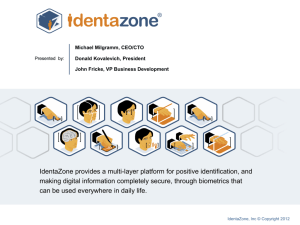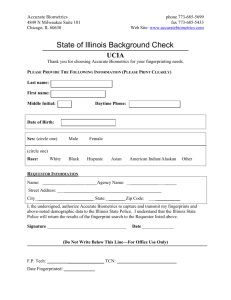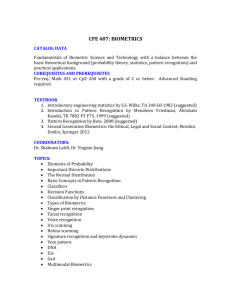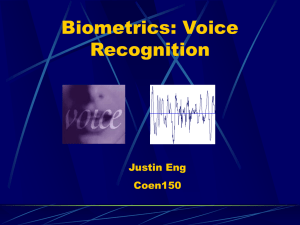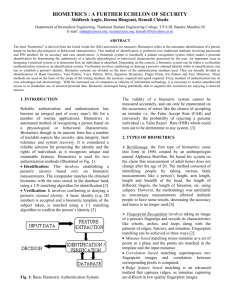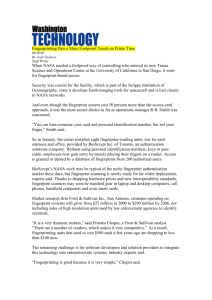PPT - University at Buffalo, Computer Science and Engineering
advertisement
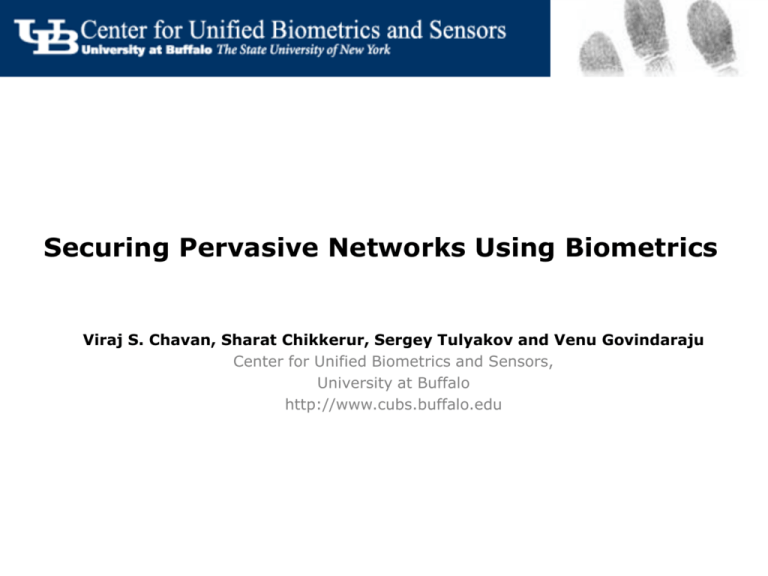
Securing Pervasive Networks Using Biometrics Viraj S. Chavan, Sharat Chikkerur, Sergey Tulyakov and Venu Govindaraju Center for Unified Biometrics and Sensors, University at Buffalo http://www.cubs.buffalo.edu Abstract Challenges in pervasive computing environments Computing devices are numerous and ubiquitous Traditional authentication including login schemes do not work well with so many devices Proposed Solution Use biometrics for authentication At the same time, ensure security of biometric templates in an open environment Contributions Propose a biometrics based framework for securing pervasive environment Implemented a novel scheme for securing biometric data in an open environment using symmetric hash functions Background “The most profound technologies are those that disappear. They weave themselves into the fabric of everyday life until they are indistinguishable from it” – Mark Weiser Pervasive Computing A web of computing devices and sensors embedded in everyday objects ranging from cars to house appliances The devices are context sensitive and user ‘aware’ Focus on human computer interaction and AI Existing efforts Project Oxygen , MIT Project Aura, CMU [2] Planet Blue, IBM [3] [1] Aspects of a Pervasive Environment User Interaction User interacts with speech, gestures and movements The sensors and computing devices are ‘aware’ of the user and in the ideal case are also aware of his ‘intent’. Proactivity The computing devices should interact and query other devices on Transparency Technology has to be transparent. behalf of the user and his intent Device interaction Frequent Multiparty interactions No central authority or third party Security and Privacy Consequences of a pervasive network Devices are numerous, ubiquitous and shared The network shares the context and preferences of the user Smart spaces are aware of the location and intent of the user Security Concerns Only authorized individuals need to be given access Authentication should be minimally intrusive Devices should be trustworthy Privacy issues User should be aware of when he is being observed The user context should be protected within the network Need to balance accessibility and security Should be scalable with multiple users operating in the network Learn from History? Wireless networks Initial research focused on implementing wireless and ad hoc networking devices and protocols Security an afterthought? Lessons for pervasive computing Human computer interface issues will be solved eventually Network infrastructure will mature Security has to be considered in the design stage Foresights Authentication has to be transparent Trusted third party may not be available Traditional key based systems will not scale well Trust based models work well with devices and agents Trust is not well defined for human user Solution: Biometrics? Definition Biometrics is the science of verifying and establishing the identity of an individual through physiological features or behavioral traits. Examples Physical Biometrics Fingerprint Hand Geometry Iris patterns Behavioral Biometrics Handwriting Signature Speech Gait Chemical/Biological Biometrics Perspiration Skin composition(spectroscopy) Why Biometrics? With numerous devices, traditional paradigm of user name and password based scenarios are not practical Only authorized users should have access to data and services Biometrics provide an unobtrusive and convenient authentication mechanism Advantages of biometrics Uniqueness No need to remember passwords or carry tokens Biometrics cannot be lost, stolen or forgotten More secure than a long password Solves repudiation problem Not susceptible to traditional dictionary attacks General Biometric System Biometric Sensor Feature Extraction Database Enrollment Biometric Sensor Feature Extraction Matching ID : 8809 Authentication Result Framework for Authentication/Interaction S1 Speaker Recognition Speech Recognition parsing and arbitration S2 SK SN Framework for Authentication/Interaction Switch on Channel 9 S1 Speaker Recognition Speech Recognition parsing and arbitration S2 SK SN Framework for Authentication/Interaction Who is speaking? Speaker Recognition Speech Recognition S1 parsing and arbitration S2 SK Annie David Cathy “Authentication” SN Framework for Authentication/Interaction What is he saying? Speaker Recognition Speech Recognition parsing and arbitration S1 S2 SK On,Off,TV Fridge,Door “Understanding” SN Framework for Authentication/Interaction What is he talking about? Speaker Recognition Speech Recognition parsing and arbitration S1 S2 SK “Switch”,”to”,”channel”,”nine” “Inferring and execution” Channel->TV Dim->Lamp On->TV,Lamp SN Speaker Recognition Definition It is the method of recognizing a person based on his voice It is one of the forms of biometric identification Depends of speaker specific characteristics. Speaker Recognition Av Pitch Impulse Train Generator Glottal Pulse Model G(z) Vocal Tract Model V(z) Radiation Model R(z) Impulse Train Generator AN Speech Production Speech production Vocal Tract Mechanism Model Modeling Generic Speaker Recognition System Speech signal Analysis Frames Preprocessing Feature Extraction Preprocessing Feature Extraction A/D Conversion LAR End point detection Cepstrum Pre-emphasis filter LPCC Segmentation MFCC Choice Feature Vector Score Pattern Matching Verification Speaker Model Enrollment Stochastic Models GMM HMM Template Models DTW Distance Measures of features Differentiating factors b/w speakers include vocal tract shape and behavioral traits Features should have high inter-speaker and low intra speaker variation State of the art in speech Literature 0.3%, Colombi et al. (Cepstrum) 6-8%, Reynolds(MelCepstrum) 4% Wan and Renals, (SVM) NIST Speaker Recognition evaluation ~1% FAR, 10-15% FRR (Text independent) Via voice IBM voice recognition engine is being open sourced ‘Speech recognition on a chip’ CMU is developing a chip architecture to completely embed speech recognition on a single chip Framework is Generic S1 Face Recognition Gesture Recognition parsing and arbitration S2 SK SN “Authentication” “Understanding” “Inferring and execution” Security of Biometric Data Issues in biometrics Biometrics is secure but not secret Permanently associated with user Used across multiple applications Can be covertly captured Fake Biometrics Types of circumvention Denial of service attacks(1) Fake biometrics attack(2) Replay and Spoof attacks(3,5) Trojan horse attacks(4,6,7) Back end attacks(8) Collusion Coercion Threats to a Biometric System Hashing Hashing Instead of storing the original password P, a hashed values P’=H(P) is stored instead. The user is authenticated if H(password) = P’. It is computationally hard to recover P given H(P) H() – one way hashing function Problem with biometrics Biometric data has high uncertainty Matching is inexact/probabilistic Therefore, hashing function should be error tolerant Biometric Hashing Hashing Schema Hashing Personalized Hashing Fingerprints 101 Minutiae: Local anomalies in the ridge flow Pattern of minutiae are unique to each individual X Y θ T 106 26 320 R 153 50 335 R 255 81 215 B Fingerprint Verification Research Challenges Fingerprint space f1 f2 • • • • h Hash space h(f1) h(f2) Images include different scanned area. Set of features is different for two different fingerprints of the same finger. Similar fingerprints should have similar hash values Hash values should be invariant to rotation/translation Hashed values 1 Hashed values 2 Same? Hash functions of minutia points Consider following functions of minutia positions: h1 (c1 , c2 , , cn ) c1 c2 cn h2 (c1 , c2 , , cn ) c1 c2 cn 2 2 2 hm (c1 , c2 , , cn ) c1 c2 cn m m m The values of these symmetric functions do not depend on the order of minutia points. Hash functions of transformed minutiae What happens with hash functions if minutia point set is transformed? h1 (c1, c2 ,, cn ) c1 c2 cn (rc1 t ) (rc2 t ) (rcn t ) r (c1 c2 cn ) nt rh1 (c1 , c2 ,, cn ) nt h2 (c1, c2 ,, cn ) c1 c2 cn 2 2 2 (rc1 t ) 2 (rc2 t ) 2 (rcn t ) 2 r (c1 c2 cn ) 2rt (c1 c2 cn ) nt 2 2 2 2 2 r 2 h2 (c1 , c2 ,, cn ) 2rth1 (c1 , c2 ,, cn ) nt 2 Symmetric Hash Functions n=2, m=1: for each minutia point we find it nearest neighbor, and c1 c2 h1 (c1 , c2 ) 2 n=3, m=1: for each minutia point we find two nearest neighbors and (c1 c2 c3 ) h1(c1 , c2 , c3 ) 3 n=3, m=2: for each minutia point find three nearest neighbors, and for each minutia triplet including original minutia point construct 2 hash functions (c c c ) h1(c1 , c2 , c3 ) 1 2 3 3 (c1 h1) 2 (c2 h2 ) 2 (c3 h3 ) 2 h2 (c1, c2 , c3 ) 3 Results We used fingerprint database of FVC2002 with 2800 genuine tests and 4950 impostor tests We obtained a best result of Total Error Rate of 4.5% as compared to a Total Error Rate of 2.5% for plain minutia-based matching Acceptable verification rates allowing for encryption of fingerprint minutia data Conclusion Smart spaces and pervasive computing are moving from concepts to implementations Security has to be incorporated in the design stage Traditional authentication and access control paradigms cannot scale to numerous and ubiquitous devices Biometrics serves as a reliable alternative for minimally intrusive authentication Biometrics solves key management and repudiation problem Securing biometrics is a major challenge in an open environment Biometric hashing can be used to create revocable biometric templates Thank You http://www.cubs.buffalo.edu Implementations of Pervasive Computing 1. MIT Project Oxygen. http://oxygen.lcs.mit.edu/videometaglue.html 2. CMU Project Aura. http://www-2.cs.cmu.edu/ aura/. 3. IBM Planet Blue, http://researchweb.watson.ibm.com/compsci/planetblue.html

